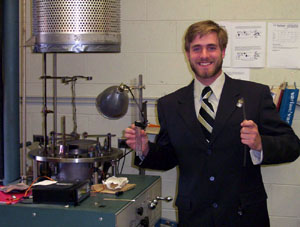 |
 |
| Brian and his gear | Custom made Palladium holder |
Hydrogen Absorption in Palladium
Brian McGuire '06
Abstract:
Hydrogen absorption in palladium was studied by looking at a thick film with experimental and computer modeling methods as well as a thin film. The thick film was massed at 602 mg and was calculated to be 5.96x10-4 m. The computer model used a difference equation to model Fick’s law of diffusion, and corresponded to the thickness and the time the sample took to hydrogenate. The thin film was made with a sputtering technique and was 2.52x10-9 m thick. Using the thick film and computer modeling data, the diffusion constant was found to be 8.66 ± 0.8 μm2/min. The amount of hydrogen absorbing into the palladium over time could also be modeled and constants for this equation were found to be α = 1.15 moles H/moles Pd and β = 42.5 s-1. The thick film was also shown to absorb 3.66 cc of hydrogen. The think film showed how the resistance of palladium drops as hydrogen is exposed to it from annealing which opens new questions into what is happening with the annealing in the structure of the palladium. This study has shown that the diffusion of hydrogen into palladium can be shown and that palladium can absorb up to 60 times its own volume in hydrogen so it would be a great storage device for hydrogen when used in a fuel cell.
For more information, contact Dr. Daniel Koon:
Return To 2006 Senior Projects
|
|
||
| © | St. Lawrence University | Department of Physics |
| Revised: 12 May 2006 | Canton, NY 13617 |